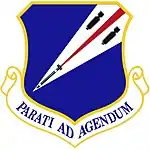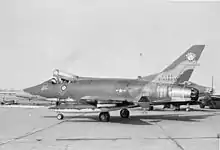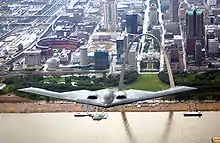131st Operations Group
The mission of the 131st Operations Group, 131st Bomb Wing, is to provide expeditionary, B-2 global strike combat support capabilities to geographic commanders and Commander, United States Strategic Command. This is done by training and equipping airmen to fly the aircraft of the 509th Bomb Wing. The group also organizes, trains, and prepares a force of citizen airmen to defend and serve the people of Missouri.[3]
| 131st Operations Group | |
|---|---|
 The B-2 "Spirit of Ohio" returns from a training mission, 27 June 2012 | |
| Active | 1943–1945; 1946–1952; 1952–1958; 1962–1974; 1993–present |
| Country | |
| Allegiance | |
| Branch | |
| Role | strategic bomber |
| Part of | Missouri Air National Guard |
| Garrison/HQ | Whiteman Air Force Base, Missouri |
| Motto(s) | Parati ad Agendum Latin Ready for Action |
| Engagements | World War II Operation Northern Watch Operation Odyssey Dawn[1] |
| Decorations | Distinguished Unit Citation[2] Air Force Outstanding Unit Award |
| Battle honours | European Theater of Operations |
| Insignia | |
| 131st Operations Group emblem[note 1] |  |
Units
- 110th Bomb Squadron
- 110th Operations Support Flight
History
World War II

During World War II, the 131st Operations Group;s heraldic predecessor, the 364th Fighter Group, organized and trained in California during 1943 before moving to England in January 1944 where it was assigned to VIII Fighter Command. The 364th flew escort, dive-bombing, strafing, and patrol missions in France, Belgium, the Netherlands, and Germany. At first the group operated primarily as escort for Boeing B-17 Flying Fortress and Consolidated B-24 Liberator heavy bombers. The group patrolled the English Channel during the Normandy invasion in June 1944, and while continuing escort operations, supported ground forces in France after the invasion by strafing and bombing locomotives, marshalling yards, bridges, barges, and other targets.

In the summer of 1944, the 364th converted from Lockheed P-38 Lightnings to North American P-51 Mustangs and until the end of the war flew many long-range missions including escorting heavy bombers to attack oil refineries, industries, and other strategic objectives at Berlin, Regensburg, Merseburg, Stuttgart, Brussels, and elsewhere. The 364th received a Distinguished Unit Citation for an escort mission on 27 December 1944 when the group dispersed a large force of German fighters that attacked the bomber formation the group was escorting on a raid to Frankfurt.
The 364th also flew air-sea rescue missions, engaged in patrol activities, and continued to support ground forces as the battle line advanced through France and into Germany. It took part in Operation Market-Garden, the effort secure bridgeheads across the Rhine in the Netherlands by air, September 1944; the Battle of the Bulge, December 1944 – January 1945; and Operation Varsity, the airborne assault across the Rhine in March 1945. Although the last mission by the 364th took place on 25 April 1945, the group did not depart until November, returning to Camp Kilmer New Jersey for inactivation
Missouri Air National Guard
The wartime 364th Fighter Group was allotted to the National Guard as the 131st Fighter Group on 24 May 1946. It was organized at Lambert Field, near St Louis, Missouri and was extended federal recognition on 15 July 1946. Assigned to the Missouri National Guard's 57th Fighter Wing, the 131st Group controlled the 110th Fighter Squadron in St. Louis and the 180th Bombardment Squadron at Rosecrans Memorial Airport, St Joseph. On 1 November 1950 the 71st Fighter Wing was inactivated and its personnel and equipment were assigned to the new 131st Composite Wing when Continental Air Command reorganized its combat units under the Wing Base organization. The 131st Wing has been the group's parent ever since.
Korean War activation
On 1 March 1951 the 131st was federalized and brought to active duty due to the Korean War. It initially transferred to Bergstrom Air Force Base, Texas as the 131st Fighter-Bomber Group was composed of the 110th Fighter Squadron, the 170th Fighter-Bomber Squadron (Illinois ANG) and the 192d Fighter-Bomber Squadron (Nevada ANG).
In November when the group was transferred to Tactical Air Command (TAC) and moved to George Air Force Base, California. At George, the unit trained for deployment overseas. On 1 December 1952, its period of federal service terminated and the group was relieved from active duty and returned to the Missouri Air National Guard, while its personnel and equipment at George were transferred to the 479th Fighter-Bomber Group.
Tactical Air Command

Returning to Lambert Field, the 131st became a light bombardment group and came under TAC for mobilization. It received Douglas B-26 Invaders that returned from the Korean War and trained primarily in night bombardment missions. With the retirement of the B-26 in 1957, the 131st entered the "Jet Age." It received its first jet aircraft in the spring of 1957 when it received some Lockheed F-80 Shooting Stars, then in June 1957, with a mission of air defense. The group was inactivated in November 1958.
After the 131st Wing returned to St. Louis after mobilization for the Berlin Crisis of 1961, the group was reactivated as the 131st Tactical Fighter Group and equipped with North American F-100C Super Sabres in late 1962. Although not activated during the Vietnam War, many of the group's pilots were sent to F-100 squadrons in South Vietnam between 1968 and 1971. The group was again inactivated in 1974, when Air National Guard tactical groups on the same base as their parent wings were discontinued and their squadrons assigned directly to the wing.
Air Combat Command

The Air Force again reorganized under the Objective Wing model and in 1993, the group again activated as the 131st Operations Group. Members were called into service to battle the Great Flood of 1993. In the post-Cold War era, the unit deployed to Incirlik Air Base, Turkey in support of Operation Northern Watch in 1996, 1997 and 1998.
On 16 March 2006, the Air Force announced that elements of the group would become an associate unit of the active duty 509th Bomb Wing at Whiteman Air Force Base. Consequently, the group transitioned from flying and maintaining the F-15C Eagle fighter to the Northrop Grumman B-2 Spirit bomber. The final flight of the F-15C Eagle by the 131st occurred in June 2009. The 509th and the 131st joined forces according to what is known as a "classic associate wing" structure. As a result, active duty and Air National Guard pilots and maintainers fly B-2 missions and sustain the aircraft as though they were one unit.[4][5]
Global Strike Command

The 131st Bomb Wing's transition to Air Force Global Strike Command occurred on 4 October 2008 when the 131st Bomb Wing held a ribbon-cutting ceremony at Whiteman. The ceremony celebrated the first official drill for traditional guardsmen at Whiteman and the grand opening of building 3006, the 131st Bomb Wing's first headquarters there. On 16 June 2009, the last F-15 departed Lambert Field. In August 2013, the 131st Bomb Wing was deemed fully mission-capable, meaning that it fully completed the transition to Whiteman Air Force Base.
Lineage
- Constituted as the 364th Fighter Group on 25 May 1943
- Activated on 1 June 1943
- Inactivated on 10 November 1945
- Redesignated 131st Fighter Group and allotted to the Air National Guard on 24 May 1946
- Federal recognition on 15 July 1946
- Redesignated 131st Composite Group on 1 November 1950
- Redesignated: 131st Fighter Group on 1 February 1951
- Called to active duty on 1 March 1951
- Redesignated 131st Fighter-Bomber Group on 9 April 1951
- Inactivated and returned to Missouri state control, 1 December 1952[6]
- Redesignated 131st Bombardment Group, Light on 1 December 1952
- Redesignated 131st Bombardment Group, Tactical in 1955
- Redesignated 131st Fighter-Interceptor Group on 15 June 1957
- Inactivated 1 November 1958
- Redesignated 131st Tactical Fighter Group
- Activated 1 August 1962
- Inactivated 30 September 1974
- Redesignated 131st Operations Group
- Activated 1 January 1993
Assignments
- IV Fighter Command, 1 June 1943 – 11 January 1944
- 67th Fighter Wing, 10 February 1944 (attached to: 1st Bombardment Division (later 1st Air Division), 15 September 1943 – 3 November 1945
- Army Service Forces, 9–10 November 1945
- 66th Fighter Wing, 15 July 1946
- 71st Fighter Wing, 1 January 1947
- 131st Composite Wing (later 131st Fighter Wing, 131st Fighter-Bomber Wing), 1 November 1951 – 1 December 1952
- 131st Bombardment Wing (later 131st Fighter-Interceptor Wing), 1 December 1952 – 1 November 1958
- 131st Tactical Fighter Wing, 1 October 1962 – 30 September 1974
- 131st Fighter Wing (later 131st Bomb Wing), 1 January 1993 – present
Components
- 110th Fighter Squadron (later 110th Fighter-Bomber Squadron, 110th Tactical Fighter Squadron, 110th Fighter Squadron, 110th Bomb Squadron), 23 September 1946 – 1 November 1952, 1 November 1952 – 1 November 1958, 1 October 1962 – 30 September 1974, 1 January 1993 – present
- 122d Bombardment Squadron, 1 January 1953 – 15 June 1957
- 169th Tactical Fighter Squadron, 1 August 1962 – 15 October 1962
- 170th Fighter-Bomber Squadron (later 170th Tactical Fighter Squadron), 1 February 1951 – 1 December 1952, 1 August 1962 – 15 October 1962
- 180th Bombardment Squadron, 1 November 1950 – 1 February 1951; 1 January 1953 – 10 April 1958
- 192d Fighter-Bomber Squadron, 1 February 1951 – 1 September 1952
- 383d Fighter Squadron: 1 June 1943 – 10 November 1945
- 384th Fighter Squadron: 1 June 1943 – 10 November 1945
- 385th Fighter Squadron: 1 June 1943 – 10 November 1945
Stations
- Glendale Airport, California, 1 June 1943
- Van Nuys Airport, California, 12 August 1943
- Ontario Army Airfield, California, 11 October 1943
- Santa Maria Army Air Field, California, c. 7 December 1943 – c. 11 January 1944
- RAF Honington (AAF-375),[7] England, February 1944 – c. November 1945
- Camp Kilmer, New Jersey, 9–10 November 1945
- Lambert Field, Missouri, 15 July 1946
- Bergstrom Air Force Base, Texas, 1 March 1951
- George Air Force Base, California, July 1951 – 1 December 1952[8]
- Lambert Field, Missouri, 1 December 1952 – 1 November 1958
- Robertson Air National Guard Base, Missouri, 1 January 1993
- Whiteman Air Force Base, Missouri, 4 Oct 2008 – present
Aircraft
- Lockheed P-38J Lightning. 1943–1944
- North American P-51D (later F-51D) Mustang, 1944–1945, 1946–1952
- North American P-51K Mustang, 1944–1945
- Douglas B-26 Invader, 1946–1957
- Lockheed F-80 Shooting Star, 1957
- Republic F-84 Thunderjet, 1957–1958
- Republic F-84F Thunderstreak, 1957–1958
- North American F-100C Super Sabre, 1962–1971
- North American F-100D Super Sabre, 1971–1974
- North American F-100F Super Sabre, 1962–1974
- McDonnell Douglas F-15A Eagle, 1993–2004
- McDonnell Douglas F-15B Eagle, 1993–2004
- McDonnell Douglas F-15C Eagle, 2004–2009
- McDonnell Douglas F-15D Eagle, 2004–2009
- Northrop Grumman B-2 Spirit, 2009–present
References
Notes
- Explanatory notes
- The group uses the wing emblem with the group designation on the scroll. Air Force Instruction 84–105, Organizational Lineage, Honors and Heraldry, 19 March 2013, para 3.3.3
- 364th aircraft is Lockheed P-38J-10-LO Lightning, serial 42-67978 "Mim / Betty A II" N2 K of Lt. Loren R. Wilson.
- Aircraft are North American P-51D-15-NA Mustang, serial 44-15493 (5E-J) and P-51K-5-NT Mustang, serial 44-11619 (5E-O) of the 385th FS, 364th FG. 5E-J, "Jeanne II" was flown by Capt. Gerald W "Jerry" Fine, and was named for his wife. 5E-O, "Boilermaker Special" was flown by Lt. Robert W. Boydston.
- Citations
- Amison, SMS Mary-Dale (25 June 2013). "From Jennies to jets to stealth bombers: 90 years of the 131st Bomb Wing and 110th Bomb Squadron". 131st Bomb Wing Public Affairs. Retrieved 8 February 2019.
- Maurer, Combat Units, pp. 247–249
- "2013 Annual Report: From the Past to the Future . . . The Missouri Minutemen". Missouri National Guard. 2013. p. 20. Retrieved 9 February 2019.
- No byline (17 March 2006). "Missouri Guard unit first ever selected for B-2 mission". Air Force News. Retrieved 9 February 2019.
- No byline (12 September 2006). "Missouri Air National Guard gets sneak preview of B-2". Air Force News. Retrieved 9 February 2019.
- Lineage through December 1952 in Maurer, Combat Units, pp. 247–249
- Station number in Anderson.
- Stations through December 1952 in Maurer, Combat Units, pp. 247–249, except as noted
Bibliography
![]() This article incorporates public domain material from the Air Force Historical Research Agency website http://www.afhra.af.mil/.
This article incorporates public domain material from the Air Force Historical Research Agency website http://www.afhra.af.mil/.
- Anderson, Capt. Barry (1985). Army Air Forces Stations: A Guide to the Stations Where U.S. Army Air Forces Personnel Served in the United Kingdom During World War II (PDF). Maxwell AFB, AL: Research Division, USAF Historical Research Center. Archived from the original (PDF) on 23 January 2016. Retrieved 28 June 2017.
- Maurer, Maurer, ed. (1983) [1961]. Air Force Combat Units of World War II (PDF) (reprint ed.). Washington, DC: Office of Air Force History. ISBN 0-912799-02-1. LCCN 61060979. Retrieved 17 December 2016.